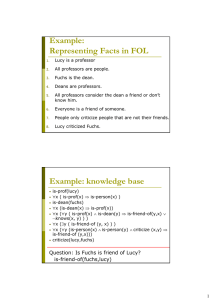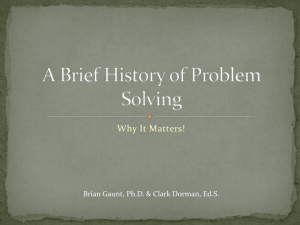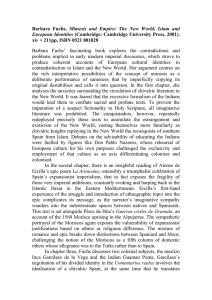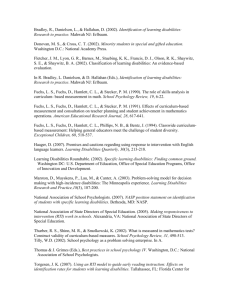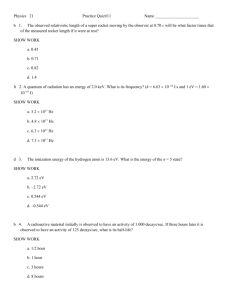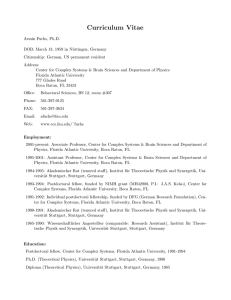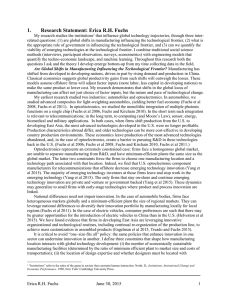Description of the Fuchs Model PHGN590 Fuchs Model the USGS TRIGA Pulse
advertisement
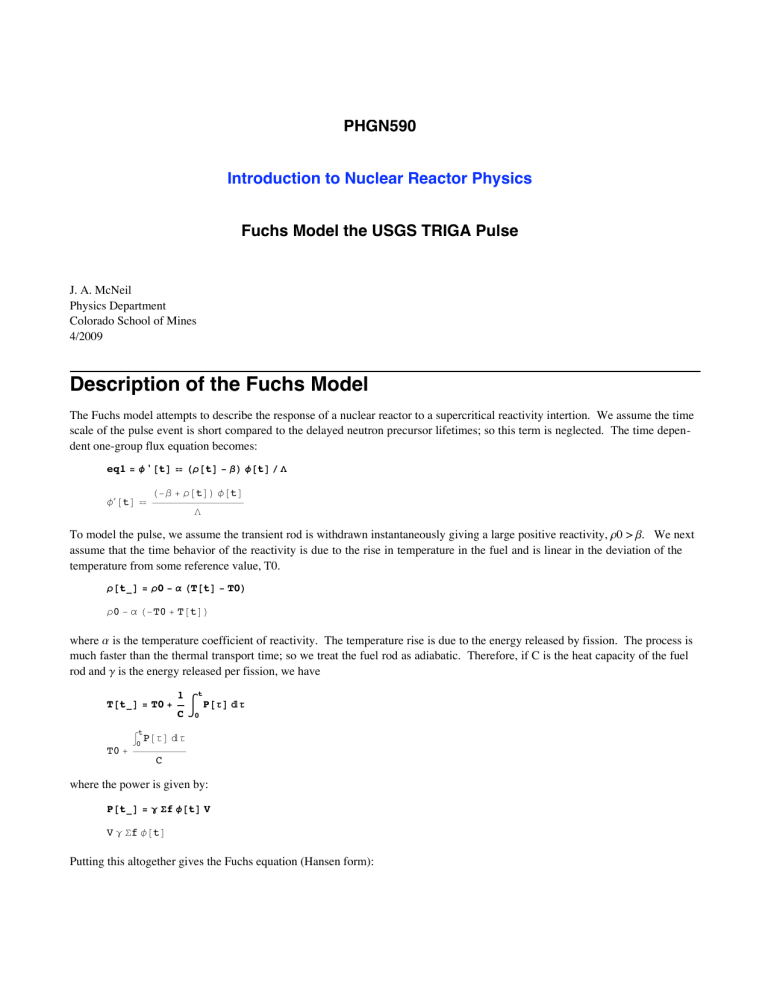
PHGN590 Introduction to Nuclear Reactor Physics Fuchs Model the USGS TRIGA Pulse J. A. McNeil Physics Department Colorado School of Mines 4/2009 Description of the Fuchs Model The Fuchs model attempts to describe the response of a nuclear reactor to a supercritical reactivity intertion. We assume the time scale of the pulse event is short compared to the delayed neutron precursor lifetimes; so this term is neglected. The time dependent one-group flux equation becomes: eq1 = f '@tD ã Hr@tD - bL f@tD ê L f£ @tD ã H-b + r@tDL f@tD L To model the pulse, we assume the transient rod is withdrawn instantaneously giving a large positive reactivity, r0 > b. We next assume that the time behavior of the reactivity is due to the rise in temperature in the fuel and is linear in the deviation of the temperature from some reference value, T0. r@t_D = r0 - a HT@tD - T0L r0 - a H-T0 + T@tDL where a is the temperature coefficient of reactivity. The temperature rise is due to the energy released by fission. The process is much faster than the thermal transport time; so we treat the fuel rod as adiabatic. Therefore, if C is the heat capacity of the fuel rod and g is the energy released per fission, we have T@t_D = T0 + 1 C Ÿ0 P@tD „ t ‡ P@tD „ t t 0 t T0 + C where the power is given by: P@t_D = g Sf f@tD V V g Sf f@tD Putting this altogether gives the Fuchs equation (Hansen form): 2 Fuchs.nb eq1 a Ÿ0 V g Sf f@tD „t t f @tD ã -b + r0 - C £ f@tD L ü Solve the Fuchs equation using a functional transformation Define the term in brackets as y[t]: y@t_D = Hr0 - bL ê L -b + r0 L a g Sf V LC V a g Sf Ÿ0 f@tD „ t ‡ f@tD „ t t 0 t - CL The initial conditions are: Clear@yD InitCond1 = y@0D ã Hr0 - bL ê L a g Sf V InitCond2 = y '@0D ã f0 LC y@0D ã -b + r0 L y£ @0D ã - V a g Sf f0 CL Take the derivative, y'[t], solve for f[t], and plug it into the Fuchs equation to get the transformed Fuchs equation: Clear@yD eq2 = y ''@tD ã D@y@tD ^ 2, tD ê 2 y££ @tD ã y@tD y£ @tD Integrate once gives eq3 = y '@tD ã Hy@tD ^ 2 - k ^ 2L ê 2 y£ @tD ã 1 2 I-k2 + y@tD2 M where k^2 is the integration constant which we solve using the initial condition #2. ksoln = r0 - b H-b + r0L2 L2 Try direct solution L + 2 + 2 a g Sf V f0 LC 4 V2 a2 g2 Sf2 f02 C2 L2 2 Fuchs.nb ysoln@t_D = y@tD ê. Flatten@DSolve@8eq3, y@0D ã Hr0 - bL ê L<, y@tD, tDD LC fsoln@t_D = ysoln'@tD a g Sf V k TanhB 1 2 -t k - 2 ArcTanhB b - r0 kL C k2 L SechA 12 I-t k - 2 ArcTanhA F F 2 b-r0 EME kL 2 V a g Sf The total energy is the integral of the power: Etotal = g Sf ‡ fsoln@tD „ t ¶ -¶ $Aborted The total energy can be obtained from y[t]: Energy@t_D = -b + r0 L - 1201.11 LC aV ysoln@tD + Hr0 - bL ê L C k L TanhA 12 I-t k - 2 ArcTanhA Va b-r0 EME kL 3 4 Fuchs.nb ü Plot the flux during the pulse dvalue = 2.; Vrod = 394.78; params = 8b Ø .007, a Ø 3. µ 10 ^ -5, C Ø 720, V Ø Vrod, g Ø 190. µ 1.6 µ 10 ^ -13, Sf Ø .12, L Ø 40. µ 10 ^ -6, f0 Ø 3. µ 10 ^ 9<; fplot@t_, d_D = HHfsoln@tD ê. k Ø ksolnL ê. r0 Ø d bL ê. params; horizaxis = StyleForm@"t HsL", FontFamily Ø "Tahoma", FontColor Ø Blue, FontWeight Ø Bold, FontSize Ø 12D; vertaxis = StyleForm@" fHtLêf0 ", FontFamily Ø "Tahoma", FontColor Ø Blue, FontWeight Ø Bold, FontSize Ø 12D; plotname = StyleForm@ " Fuchs Model of Reactor Response to Supercritical Insertion of Reactivity", FontFamily Ø "Tahoma", FontColor Ø Black, FontWeight Ø Bold, FontSize Ø 14D; fscale = f0 ê. params; tplot = 0.3; Plot@8fplot@t, dvalueD ê fscale<, 8t, 0, tplot<, PlotStyle Ø 88Red, Thickness@.005D<<, Frame Ø True, GridLines Ø Automatic, PlotLabel Ø plotname, FrameLabel Ø 8horizaxis, vertaxis<, ImageSize Ø 600, Background Ø LightYellow, PlotRange Ø AllD Fuchs Model of Reactor Response to Supercritical Insertion of Reactivity 3.5 µ 106 3.0 µ 106 2.5 µ 106 fHtLêf0 2.0 µ 106 1.5 µ 106 1.0 µ 106 500 000 0 0.00 0.05 0.10 t HsL 0.15 0.20 0.25 0.30 Fuchs.nb ü Find the peak location and evaluate the peak flux tpeakGuess = .12; dfdt@t_, d_D = Simplify@fsoln'@tDD; dfdtplot@t_D = HHHdfdt@t, dD ê. k Ø ksolnL ê. r0 Ø d bL ê. paramsL ê. d Ø dvalue; Plot@dfdtplot@tD, 8t, 0., 2 tpeakGuess<, PlotRange Ø AllD tpeak = t ê. FindRoot@dfdtplot@tD, 8t, tpeakGuess<D; fpeak = fplot@tpeak, dvalueD; fpeakRatio = fpeak ê f0 ê. params; Plot@fplot@t, dvalueD - fpeak ê 2, 8t, tpeak - tpeak ê 2, tpeak + tpeak ê 2<D thalf = t ê. FindRoot@fplot@t, dvalueD - fpeak ê 2, 8t, tpeak ê 2<D; Etotal = Limit@HHEnergy@tD ê. k Ø ksolnL ê. r0 Ø dvalue bL ê. params, t Ø ¶D; DT = Etotal V ê C ê. params; Print@" The peak occurs at t = ", tpeak, " s"D Print@"The peak flux is ", fpeak, " êcm^2ês"D Print@"The peak flux ratio is ", fpeakRatioD Print@"The pulse width is ", 2 Abs@tpeak - thalfD, " s"D Print@"The total energy released is ", Etotal, " J"D Print@"The temperature increase of the fuel is ", DT, " 6 µ 1017 4 µ 1017 2 µ 1017 0.05 0.10 0.15 0.20 -2 µ 1017 -4 µ 1017 -6 µ 1017 4 µ 1015 2 µ 1015 0.08 -2 µ 1015 -4 µ 1015 0.10 0.12 0.14 0.16 0.18 C"D 5 6 Fuchs.nb The peak occurs at t = 0.120781 s The peak flux is 1.02072 µ 1016 êcm^2ês The peak flux ratio is 3.40241 µ 106 The pulse width is 0.0201457 s The total energy released is 600.553 J The temperature increase of the fuel is 329.287 C

